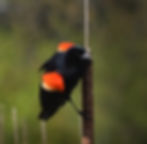All About Marshes: Birds of the Marsh
- Jared Parks, LSLT Director of Land Programs
- Aug 6, 2024
- 3 min read
Living on the edge can be a mixed bag. Edges or ecotones (the transition zone of one habitat type to another) offer the benefit of easy access to resources available in multiple habitats. However, edges also create the potential for increased competition for those same resources. Creatures living in these zones experience environmental conditions that can be dynamic and difficult. Both terrestrial edges (for example, open fields giving way to dense forest) and aquatic-terrestrial boundaries can change abruptly, but the added dynamics inherent in the latter create opportunities and stresses not found in the former. Due to these factors, some very uniquely adapted species can be found in both fresh and saltwater tidal marshes.

Great Egret wading. Photo credit: Steve Hillebrand, USFWS
The Marshes for Tomorrow project is focused on identifying, preserving, and restoring the best high marsh habitat (see the Salt Marsh Structure article for description) in the lower Chesapeake Bay and the Atlantic Coastal Bays for the saltmarsh sparrow (Ammospiza caudacuta), a species experiencing rapid population decline. This species is at a heightened risk from rising sea levels as it builds its nest on or very close to the ground.

Saltmarsh Sparrow perched on a bush. Photo credit: Frank Lehman
Interestingly, the saltmarsh sparrow’s eggs are better adapted than most bird eggs to handle minor amounts of inundation without spoiling, and its nest has higher, inwardly curved sides to help keep the eggs from floating away when flooded by a small amount of water. However, these adaptations allowing the sparrow to live in this environment are proving inadequate to protect against the current scale of sea level rise and climate-change induced weather patterns. The saltmarsh sparrow has experienced an 87% population decline since 1998 due to low breeding productivity. Maryland plays a key role in preserving the species because its breeding population is estimated to be 25% of the regional population of saltmarsh sparrow.
Other interesting species that share Maryland’s tidal marshes with the saltmarsh sparrow include:
Black Rail

Close-up of the elusive Black Rail. Photo Credit: Tom Johnson
The black rail is one of the most elusive of our marsh species. Given its small size (5-6 inches), secretive habits, and low population, this is one of the most difficult marsh birds to find.
Marsh Wren

Marsh Wren at John Heinz National Wildlife Refuge. Photo credit: Bill Moses, USFWS
This small bird has a large personality and is very industrious. Males will build up to 20 dummy nests that serve the dual purpose of confusing predators and providing extra nighttime roosts for adults.
Red-winged Blackbird

Red-winged Black Bird on Cattail. Photo credit: Steve Arena (USFWS Volunteer)
While the work of Marshes for Tomorrow has set the saltmarsh sparrow as a target species, the species listed above (and many others) will reap the benefits.
Marshes for Tomorrow (MfT) is an ambitious project led by Audubon mid-Atlantic and regional partners of the Delmarva Restoration and Conservation Network (DRCN) to identify, protect, and restore at least 25,000 acres of the most important tidal salt marsh habitat on Maryland’s Eastern Shore for saltmarsh sparrows. MfT is utilizing the most recent scientific analysis coupled with community input to select the areas to concentrate our efforts. If you would like to learn more about MfT or join one of our upcoming public meetings, please visit the MfT website at https://www.delmarvarcn.org/marshesfortomorrow.
